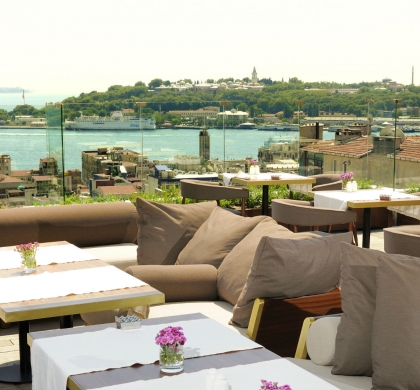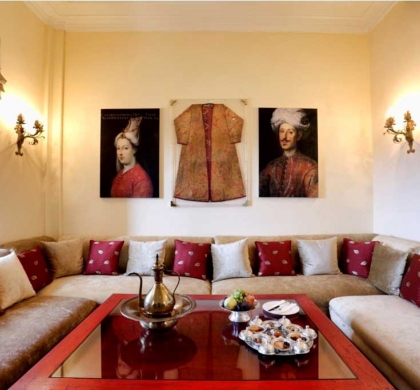Buy or gift a stand-alone digital subscription and get unlimited access to dozens of back issues for just £18.99 / $18.99 a year.
Please register at www.exacteditions.com/digital/cornucopia with your subscriber account number or contact subscriptions@cornucopia.net
Buy a digital subscription Go to the Digital EditionThe indomitable Dame Ninette de Valois, who died aged 102, held a special affection for Turkey, where in the post-war years she created the national ballet from scratch. Two of her protégés reminisce to Elizabeth Meath Baker and her visits to Ankara are recalled by the former ambassador Sir Bernard Burrows
When Ninette de Valois accepted an invitation in 1947 to come to Turkey to see about setting up a national ballet company, those who knew her well were probably confident that she could succeed, as she had in Britain, in creating a ballet company from scratch where there was no previous tradition. She was famous, indeed notorious, for her discipline, grit and determination, as much as for her greatness as an artist and teacher, and known as something of a martinet in what was then Sadler’s Wells Ballet, later to become the Royal Ballet. But surely no one could have anticipated the extent of her success and, more, the profound mutual affection which would develop between her and ‘Madam’s Turks’, as her protégés came to be called.
Richard Glasstone, who joined the fledgling company as resident choreographer in Ankara in 1965, was appointed by Dame Ninette. He felt the closeness of her relationship with Turkey came from many sources. One of these was her Irishness – she warmed to what she spoke of as an “Irishness” in the Turks. Another was the empathy she felt as a result of her own early struggles in establishing the English ballet at Sadler’s Wells and the Old Vic under Lilian Baylis.
In her book Step by Step, she described the evolution of the Turkish ballet and she tells the story of how, at the age of ten, she was given a dancer’s charm, a tiny gold coin, by a visiting Persian prince, after performing for him in a London drawing room. Engraved on it were the words ‘Allah guide thy feet’ . In her words, ‘They were guided to the shores of Asia Minor in no uncertain fashion some thirty-five years later.’
It is unclear who actually decided she should be invited to Turkey. Turkish audiences had only seen occasional visiting ballet companies (the very earliest of these, courtesy of the Italian community in the sixteenth century, is briefly described in Metin And’s History of Theatre and Popular Entertainment in Turkey, published in 1964), but professional dancing for entertainment, however disreputable it might seem as a career, was still an historic institution and hugely popular.
By the time Richard Glasstone arrived, the Turkish State Ballet, from its small beginnings, was clearly well on the way to becoming a proper company. Glasstone himself was being handed an exceptional opportunity: born in the Belgian Congo, trained in South Africa and then in London, and having worked for two years in Holland, he did not have the profile to be taken on directly by the Royal Ballet. But by sending him to Turkey as her man, ‘Madam’ gave him the chance to prove himself with a young and enthusiastic company at his disposal. Later, she would see about finding him a place in London. She had also clearly detected the need for a choreographer who was a teacher too – after four years in Ankara, Glasstone went on to work for 17 years at the Royal Ballet School.
In those early days, only Dame Ninette could see off serious trouble. Her word was law. One of her great concerns was to ensure that the ballet did not play second fiddle to the opera. In London she had more or less succeeded in this. In Ankara, there were obstacles to overcome. The opera had been started well before the ballet; the music conservatoire was more established. Design, sets, wardrobe, lighting and stage management, all belonging to the opera, were run on German lines, and the approach could be less than flexible.
The designer Osman Şengezer began his career assisting the German stage designer, having done part of an architect’s training. At one meeting about sets for de Valois’ The Rake’s Progress (Hovardanın Sonu), with at least 15 people present, everyone was making excuses to her about how they could not produce the shades of ‘elephant’ grey needed for Hogarth’s seven great tableaux. A young voice, Şengezer’s, was heard: ‘I can make it,’ he said, and he did. He was just 19…
The indomitable Dame Ninette de Valois, who died aged 102, held a special affection for Turkey, where in the post-war years she created the national ballet from scratch. Two of her protégés reminisce to Elizabeth Meath Baker and her visits to Ankara are recalled by the former ambassador Sir Bernard Burrows
A new book on Vassilaki Kargopoulo: Photographer to His Majesty the Sultan. By Philip Mansel
Dedicated to Venus by the Romans, no other fruit has so many symbolic and material associations with sensual beauty. Lovely soft pink flowers are followed by crimson velvetly fruit, soft and round, with a heavenly taste and aroma.
More cookery features
William Morris and Mariano Fortuny familiarlised the West with the sumptuous floral designs of Ottoman textiles. But few are aware of the the bolder side of Turkish design
The intoxicating scent of attar of roses, the oil distilled from the petals of damask roses, has worked its magic on men and women for centuries. Martyn Rix traces the history of the damask rose from its roots in Neolithic times and travels to Isparta in southwest Anatolia to see how these precious petals yield up a liquid worth its weight in gold
Few travellers to Turkey enjoying the hedonistic delights of Mediterranean cruising venture east of Antalya, capital of Anatolia’s Turquoise Coast – intimidated perhaps by rumours of a wild hinterland that even Alexander the Great found hard to tame. But those who dare to leave the crowds behind will discover an awe-inspiring landscape of cliffs that drop sheer to the sea, epic castles and remote Byzantine retreats. Kate Clow and Jacqueline de Gier joined ten other guests and a lecturer for a twelve-day voyage of enlightenment aboard a traditional gulet
Geoffrey Lewis, acknowledged as the dean of Turkish studies in Britain and beyond, learned the language while serving in the RAF in Egypt. When he finally visited Turkey, he was smitten for good. By Andrew Mango. Portrait by Charles Hopkinson
For more than thirty years Terence Mitford and George Bean painstakingly identified and recorded the forgotten ancient sites of Turkey’s Aegean and southern shores. Their contribution to the preservation of the country’s archaeological heritage is incalculable, their guidebooks are legendary, yet the men themselves are unsung. Barnaby Rogerson, in this homage to his heroes, uncovers an extraordinary pair: a gentle giant and a man of steel
The dusty rooms of a crumbling Istanbul palazzo are a living museum of the plaster-caster’s art. Berrin Torolsan visits the heir to a fine tradition. Photographs by Fritz von der Schuelnburg




Cornucopia works in partnership with the digital publishing platform Exact Editions to offer individual and institutional subscribers unlimited access to a searchable archive of fascinating back issues and every newly published issue. The digital edition of Cornucopia is available cross-platform on web, iOS and Android and offers a comprehensive search function, allowing the title’s cultural content to be delved into at the touch of a button.
Digital Subscription: £18.99 / $18.99 (1 year)
Subscribe now